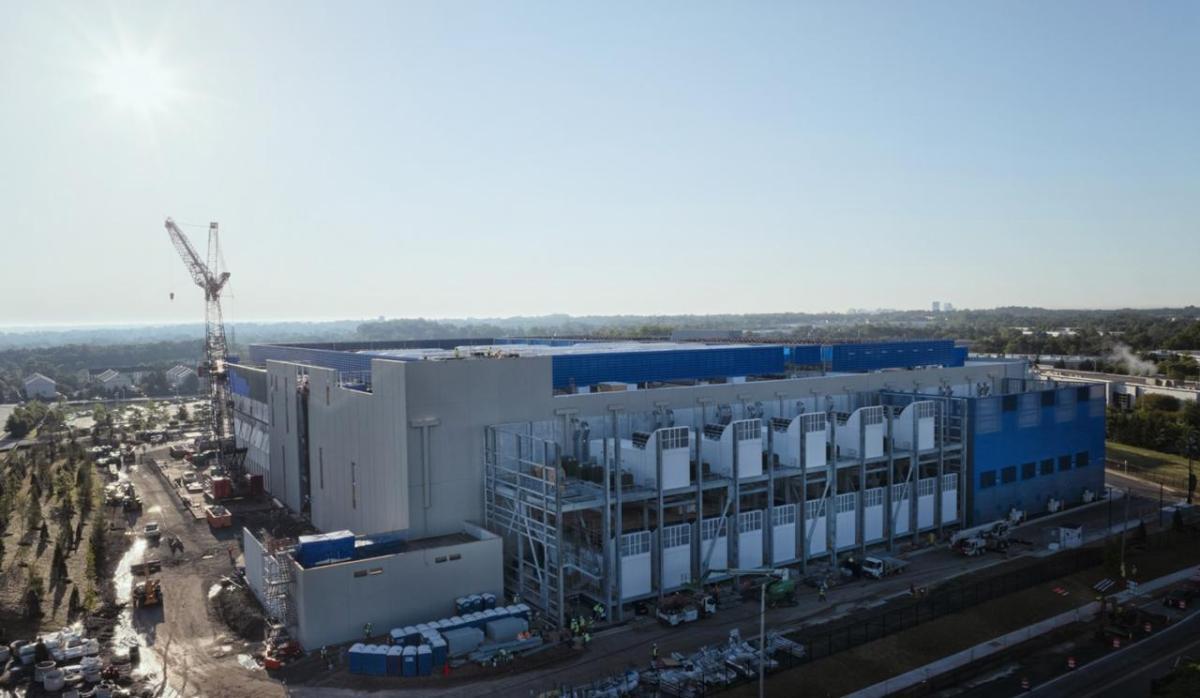
Managing Industrial Hygiene Risks In The Growing Data Center Construction Market
In traditional data center construction, the building is constructed entirely on-site from the ground up. Recently, modular data center construction has become increasingly popular. This type of construction involves prefabricating modules or units off-site in a controlled factory environment. These modules, which include the most necessary infrastructure and equipment, are then transported to the site and assembled.
This method can help reduce construction time, and it also offers scalability and flexibility, as additional modules can be added as needed. In some cases, the controlled environment of a factory can lead to improved quality control and reduced on-site labor and construction risks. However, modular data center construction comes with its own unique risks and hazards on site.
Data Centers and Industrial Hygiene
In all forms of construction, Industrial Hygiene (IH) must be diligently managed. With data centers in particular, tasks associated with IH or Occupational Health Risks are often deemed“High Risk Activities (HRAs).” These risks are significant due to their potential long-term and debilitating effects. Guidance is provided through OSHA Construction Standards, as well as Consensus Standards or Guidelines from ANSI, NFPA, ACGIH, various Trade Associations, and Manufacturers' Safety Data Sheets (SDSs).
Whether your construction site is traditional or modular, training and awareness are essential first steps to managing these risks effectively. Below is a list of potential IH risks and hazards commonly encountered on data center construction sites. Note that this is not exhaustive but rather a sample of the risks that need to be managed on any given site.
Key Data Center IH Risks and Best Practices to Mitigate Them
1. Noise Exposure
Construction sites are inherently noisy, and data center construction is no exception. Common sources of noise include construction equipment, hydrovac operations, portable powered tools, and load bank testing equipment.
Best Practices:
- Provide training and awareness about the equipment used.
Choose quieter equipment when possible.
Minimize exposure periods.
Ensure the team uses the appropriate Personal Protective Equipment (PPE).
2. Heat Stress
Heat stress can be a significant risk depending on the time of year and the construction site's geographical location. It's crucial to monitor weather conditions, including the heat index, which combines temperature and humidity levels to gauge how hot it feels.
When the heat index is high, it's harder for the body to cool down via sweating, which can lead to dangerous symptoms such as dizziness, weakness, fatigue, muscle cramps, fainting, and more. The safest way to manage heat exposures is to plan ahead and do the following:
Best Practices:
- Train workers on recognizing and managing heat stress.
Allow workers to acclimatize over 1-2 weeks.
Monitor and communicate weather and heat conditions.
Provide cooling stations or cooling vests and promote hydration.
Adjust work schedules to cooler times of the day or at night, if necessary.
3. Cold Stress
Similarly, cold weather poses risks, particularly with freezing temperatures and wind chills, which can exacerbate exposure dangers. High winds can drive down the wind chill and lead to even more dangerous conditions, if a person isn't properly prepared.
Best Practices:
- Train workers on risks of cold stress and proper garment choices.
Provide warming stations.
Monitor and communicate changing conditions.
Adhere to the Wind Chill Chart Guidance from NOAA.
Promote hydration even in cold weather to prevent dehydration and hypothermia.
4. Temporary Space Heating Systems
Another risk in cold temperatures is the use of temporary heaters, which are often used before the data center has heat or electricity. With these heaters, there is a risk of carbon monoxide entrainment through the air intakes of the equipment.
Best Practices:
- Check the placement of air intakes and ensure proper carbon monoxide monitoring of the warmed air being introduced into the building.
Place heating units properly and use only indirectly fired heaters.
Communicate to all occupants the locations, functions, and required emergency response to alarms in work areas.
5. Crystalline Silica
Crystalline silica is typically found in construction materials such as concrete. Activities like drilling, cutting, grinding, or crushing these materials produce“respirable” particles that can lead to serious health conditions if inhaled, such as silicosis, an incurable lung disease that can lead to disability and death, lung cancer, chronic obstructive pulmonary disease (COPD), and kidney disease .
Best Practices:
- Train workers on risks of crystalline silica exposure and methods to mitigate the risks.
Follow water application protocols to reduce dust while cutting, drilling, etc.
Ensure proper ventilation. Localized ventilation devices attached to tools can serve as an effective means of exposure control.
Monitor and communicate conditions to the team. Be mindful of risks to adjacent work crews.
6. Epoxy Resins & Hardeners
Uncured epoxy resins are potent irritants and sensitizers. Skin contact with the hardening agent can cause burns, rash, swelling, and itching. Inhaling these chemicals can also lead to lung irritation.
Best Practices:
- Train workers on handling and disposing of epoxy waste properly.
Use impervious gloves and proper PPE to avoid contact
Ensure good local ventilation.
7. Floor Cleaners for Rust Removal
While modular construction is becoming increasingly more popular, it can still have unintended consequences, such as a potential for reduced quality and increased health and safety risks. For example, when the modules are bolted together, sometimes, there can be leaks when it rains during construction. Leaks can lead to many issues including rusting on floor surfaces and in corners, which requires removal. Rust removal can involve the use of corrosive chemicals, which pose risks when inhaled or contacted with skin.
Best Practices:
- Train workers and raise awareness.
Use proper gloves and ventilation.
Ensure eye/face protection and proper disposal of waste materials.
8. Spray Application of Polyurethane Insulation
Polyurethane insulation contains chemicals called isocyanates, which, when inhaled can cause irritation to the lungs. It can also cause skin irritation if you make direct contact with it.
Best Practices:
- Provide training and awareness.
Monitor work conditions.
Wear air-supplied hoods and establish Controlled Activity Zones (CAZs).
Use Manifold Mixing Application Wands for safer application.
9. Construction Lasers
Lasers are a standard construction tool for alignment, elevation, surveying, and more. Certain lasers can cause a risk to the eyes and skin.
Best Practices:
- Ensure proper training and awareness.
Use ANSI Z136 compliant equipment.
Implement HRA work permits on the construction site.
10. Concrete Mix Compounds
When pouring concrete on a construction site, anyone near the discharge spout is at risk for exposure to that corrosive material. Not only can it be an irritant to the lungs, but it is a potential irritant and sensitizer to the skin.
Best Practices:
- Provide training and awareness.
Use wetting techniques where practical.
Ensure proper PPE is used and HRA work permits are implemented.
Adjust work schedules in hot temperatures to avoid heat stress for those wearing PPE to pour concrete.
11. Roof Adhesives and Solvents
In modular data center construction, the roof membrane typically has to be attached to the building modules. In this process, organic solvents and adhesives are needed to ensure the roof is properly bonded to and seals the modules. These chemicals can be potential irritants and sensitizers and can impact the skin, eyes, and lungs.
Best Practices:
- Provide training and awareness.
Use prescribed PPE and HRA work permits.
Provide Portable Eye Wash Fountains near use points.
12. Confined Spaces Entry During Construction Phase
Confined spaces are common on construction sites, and while they are necessary, they are not meant for people to occupy for a long period of time. In these confined spaces, workers can also be exposed to potential chemical inhalations, electrocutions, explosions, and other hazards. All of this is made even more concerning by the fact that these spaces make exiting difficult in the event of an emergency.
Best Practices:
- Ensure only properly trained workers can enter confined spaces
Use Confined Space Entry (CSE) permits
Monitor the space using multi-gas monitors.
Follow proper confined space protocol.
Have rescue teams on site in case of emergency.
13. Welding Hazards
Onsite welding is routinely required during most construction projects. Key health hazards include non-ionizing radiation generated from the welding process with flash exposure risks to unprotected eyes and breathing zone atmospheric risks. Common inhalation risks during construction welding operations include zinc fumes that can be generated from welding or cutting on galvanized steel.
Best Practices:
- Assure all welders and those providing nearby assistance are properly trained on hazards and protected through shielding from Ionizing radiation.
Provide training and awareness about the hazards of welding fumes and airborne exposure control practices. This should include the steps necessary to prevent“zinc fume fever.”
Utilize“Hot Work” permits and monitor work conditions during and after the welding and cutting operations. This will manage fire risks as well as those related to occupational exposures.
Wear respiratory protection as needed and utilize Controlled Activity Zones (CAZs).
Use welding fume exhaust systems as conditions may require.
Follow guidelines from the American Welding Society (AWS). These include AWS Z49.1 - Safety in Welding, Cutting, and Allied Processes.
Key Takeaways: Managing Risks Matters
Construction is necessary but can bring all sorts of risks and hazards to the workers on the site. This list gives you a small taste of IH risks that might pop up and that will have to be managed. But IH is only one of the many categories of risk that requires management on a construction project. Being prepared, trained, and aware is the best way to tackle any risk and keep yourself and your team safe.
Do you have questions or want help with IH at your site? Reach out to our team of experts today !

Legal Disclaimer:
MENAFN provides the
information “as is” without warranty of any kind. We do not accept
any responsibility or liability for the accuracy, content, images,
videos, licenses, completeness, legality, or reliability of the information
contained in this article. If you have any complaints or copyright
issues related to this article, kindly contact the provider above.


















Comments
No comment